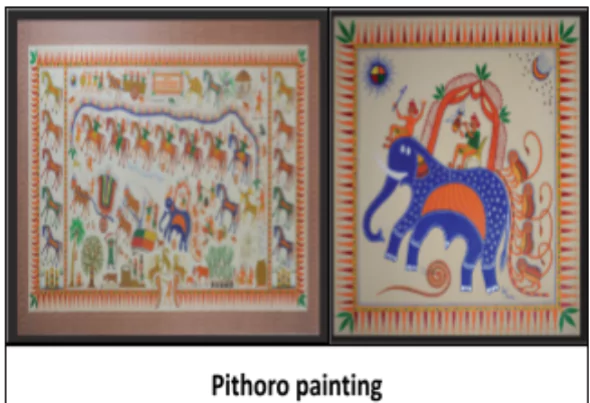Introduction
Folk paintings in India encompass a plethora of styles and themes, each reflecting the unique cultural heritage of its region. These artworks hold significant importance in preserving indigenous traditions and narratives.
Various Folk Paintings
- Thangka Paintings: These paintings are created by Buddhist monks.
- Painted on a white cotton canvas, serving as the background.
- The paints used are derived from natural sources like vegetable dyes or mineral dyes.
- It is spread in regions like Sikkim, Himachal Pradesh, Ladakh, and Arunachal Pradesh.
- Manjusha painting of Bihar: It originates from the Bhagalpur region of Bihar and is alternatively known as Angika art, where ‘ang’ signifies one of the Mahajanapada regions.
- It often features snake motifs, earning them the nickname “snake painting”.
- Primary canvas: They are created on jute boxes and paper.
- Phad scroll Painting of Rajasthan: It is religious art, featuring local deities.
- Figures with large eyes and round faces & portray scenes of processions and festivities.
- Crafted using vegetable colours on elongated cloth known as “phad”.
- Cheriyal Scroll Paintings of Telangana: They belong to the Nakashi art tradition. In 2007, this art form was granted GI tag.
- It can be larger in size, reaching heights of up to 45 feet.
- The scrolls represent a continuous story like comics or ballad by the Balladeer community.
- Revolve around Hindu Epics and Puranic stories.
Enroll now for UPSC Online Course
- Saura Paintings in Odisha: They are similar to Warli paintings and painted by the Saura tribe.
- Take the form of wall murals with ritualistic importance.
- Human figures depicted exhibit a distinctive geometric and stick-like appearance.
 Material Used: Colours extracted from natural sources (minerals and plants)
Material Used: Colours extracted from natural sources (minerals and plants)- Pithoro painting:This painting was painted by Rathva Bhils of the Panchmahal region in Gujarat and Jhabua in the neighbouring state of Madhya Pradesh.
- These paintings are done on the walls of houses to mark special occasions.
- These are large wall paintings, representing rows of coloured deities depicted as horse riders.
- Mata-ni-Pachedi: In Ahmedabad, Mata-ni-Pachedi paintings on cloth pertaining to the mother goddess cult are made as votive offerings.
- The painting is done during the time of navaratra.
- The Vaghari community is especially known to paint these pachedis. Only the men paint; the women are not allowed to conduct the sacred ritual.
- Sanjhi: The unmarried young girls in the villages of Punjab, Haryana, Rajasthan, Madhya Pradesh, Bihar and Uttar Pradesh prepare the image of the goddess Sanjhi worshiped during Navratri.
- As these paintings are made in the evening, they are coined with the name ‘Sanjhi’ or ‘Sangya’ or ‘Chandra Tarayya’.
- Chitrakathi Painting: In medieval Maharashtra and some parts of Andhra and Karnataka, there was a section of people known as Chitrakathis.
- They travelled from village to village and narrated mythological stories to people with the help of these single sheet paintings.
- The Chitrakathi patas draw their theme from the Ramayana and the Mahabharata or the Puranic legends.
- Kalighat Painting: These paintings are done by Patua who migrated to Kolkata and set up their shop chiefly around the Kalighat temple, where goddess Kali is worshiped.
- Pichhvai: Pichhvai paintings are done on cloth and serve as painted backdrops for installed icons of Shrinathji at Nathadwara in Rajasthan. Themes include the Life of Krishna, seasons etc.
- Ganjifa Card: The word ‘Ganjifa’ literally means the wealth of money and grains.
- The artists of Bishnupur in Bankura district of West Bengal produced a special set of cards known as Ganjifa cards in the 14th century C.E., a substitute for present day playing cards.
- They depicted ten avatars or incarnations of Lord Vishnu.
- Historical references are found in books like Humayunnama and Abul Fazal’s Ain-i-Akbari.
- These cards are also found in Odisha, Maharashtra and Mysore.
Conclusion
- The diverse range of Indian folk paintings showcases the rich tapestry of the country’s cultural diversity.
- Through their vibrant colors and intricate designs, they offer a glimpse into the traditions, beliefs, and stories of various communities, contributing to the rich mosaic of Indian art and heritage.
![]() April 18, 2024
April 18, 2024
![]() 1524
1524
![]() 0
0
 Material Used: Colours extracted from natural sources (minerals and plants)
Material Used: Colours extracted from natural sources (minerals and plants)